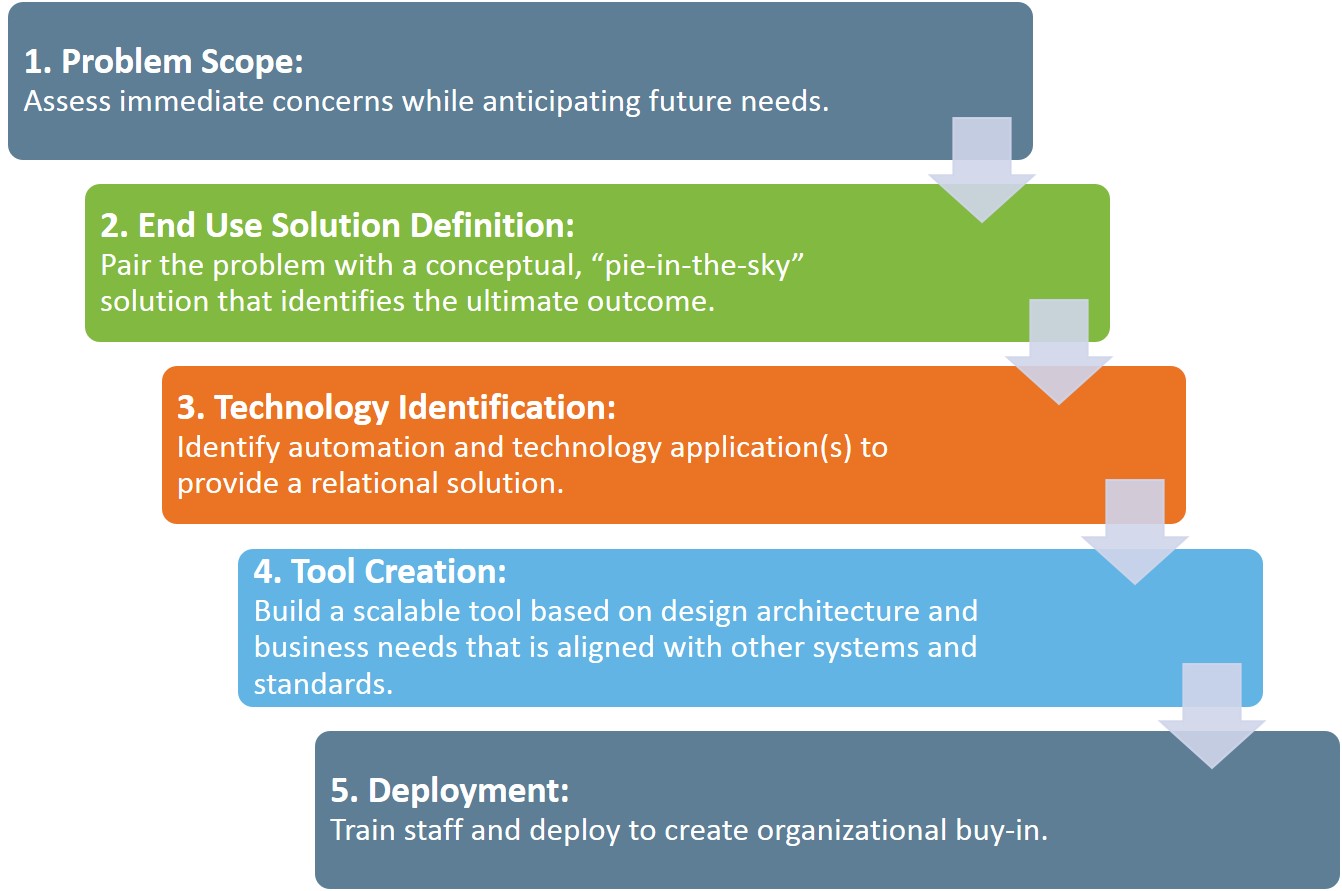
Technology Enabled Business Solutions
Comments: No Comments
Companies grasp the importance of using technology to create business efficiencies. Integrating technology into traditional processes allows companies to stretch and empower limited resources. It offers ways to provide more value to company operations and management systems.
Traditional Solutions
When it comes to technology integration, however, companies traditionally look for an isolated solution to a single problem—a find-it, fix-it approach. A simple example of this would be creating an Excel spreadsheet to manage data from multiple sources. While this creates an improvement beyond the traditional hard copy binder, it is a linear, isolated solution to one issue that offers minimal additional business value.
Consider the data on that spreadsheet and consider how business systems work. Does the data stand alone or does it impact other parts of the business? Does the business system operate in a silo or are there common elements with other business systems? In most cases, there is overlap between data, information, systems, platforms, etc. As a result, building a patchwork of technology solutions to address individual problems is only a short-term fix.
Relational Approach
Truly valuable technology solutions take a relational approach that considers the immediate issue within the context of the overall business need, and then integrates multiple platforms/systems, as required, into an aligned system.
A forward-thinking, relational technology approach takes a solution perspective that thinks beyond the singular project need to the big picture and then designs backward. It’s a shift in mindset from “How can I use technology to make this efficient?” to one that asks, “Ultimately, what does the big-picture, desired state look like…and how can technology get us there?”
A relational approach such as this follows these steps:

Case Study in Technology Integration
The following case study provides a real-world example of how a global chemical distributor is following these steps to create a relational technology solution that will improve business efficiencies across the company. Initially, this distributor wanted to pull data from facility reports for 150+ locations into one database—that was the “simple” problem. The old system had facilities entering data into Excel forms. That information was then pulled into Access so the data could be manipulated.
Understanding that the facility data is intertwined with many aspects of the business, Kestrel looked beyond this singular issue at the bigger picture. The forward-thinking solution would be to create a technology platform that would solve this facility data problem and could easily be expanded to other business needs, particularly since facility data is tied to most aspects of the business.
To do this, Kestrel built the facility form into SharePoint as the base application for the company’s overall system. SharePoint houses all data previously input into Excel documents for each facility broken up by 11 regional operating companies with multiple locations under each. The form requires that each facility contact fill out quarterly information on the facility (e.g., permits, fleets, transportation, personnel). Beyond the facility form, the SharePoint system currently has the following modules, which all feed into the facility form:
- Facility images
- Storage tanks
- Facility audits
- Sustainability
The SharePoint system is continuing to be expanded to integrate other systems into a single source that will create significant business efficiencies. This approach is creating many benefits across the company:
- The company is able to collect multiple levels of data and then associate that data to the individual facility or provide a composite report (i.e., data required for storage tanks, sustainability efforts, audits conducted).
- The look and feel of the forms in SharePoint are very similar to the original Excel documents, so it is an easy transition and very intuitive system to use. Little training has been required.
- The company can easily track information on all facilities. Management can export data to Excel and create reports. The company has complete ownership of data and deliverables.
- The system can create alerts for overdue items and generate real-time metrics and dashboards. Many additional options can be further customized based on ongoing business needs.
- Additional data from other systems being used across the company (e.g., auditing program) can be integrated and aligned into SharePoint as users become more familiar with the platform.
Why SharePoint?
SharePoint is a dynamic solution tool that can be customized and designed to capture data and provide consolidated reporting to all levels of management. Because of SharePoint’s flexibility, the possibilities of what it can do are virtually endless:
- Creates a single, familiar platform that simplifies access
- Provides functionality for continual adaptation to meet future data management and reporting needs
- Adapts to the needs of the business, rather than the business adapting to the capabilities of the program
- Maximizes efficiency and connectivity between many field and corporate groups
- Allows information to be shared and tracked in multiple ways
- Allows users to easily create complex databases that are both manageable and flexible
- Gives the ability to manage sites/facilities/plants/departments for compliance purposes
- Simplifies the data entry process by providing user-friendly functionality
- Consolidates reporting
- Provides a dynamic solution – updates made to the tool are reflected immediately
- Allows local users to control and build sites to their specifications
- Allows all levels of users to work with it easily due to its intuitive nature
By having so many features and applications on a single platform, it is easy to tie them all together into an aligned system and to create multiple functions/uses for the data being collected from so many sources. With an aligned system, then, achieving the big-picture, desired state (rather than the short-term fix) becomes entirely possible.
